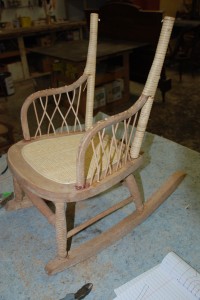Now that we all survived the end of the world, and we survived the holiday deadlines, I can get back to  posting some of our more interesting and unusual projects.
posting some of our more interesting and unusual projects.
2012 brought us some challenging jobs. The child’s wicker rocker in this post is one such challenge. Having been passed down through our client’s family, it finally reached a point where it couldn’t be rocked any more.
As you can see in the first group of photos, it was time for some TLC.
Many family heirlooms of this type have been thrown away needlessly.

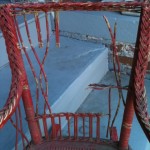 People are usually thrilled when they learn we can
People are usually thrilled when they learn we can
actually restore a piece in this condition. But, not so thrilled with the time it takes to complete them. Restoring anything in this condition involves many steps, beginning with some time for the artisans to evaluate what needs to be done.
This restoration began by stripping away several coats of paint that had been applied over many years. I’ll admit that a fresh coat of paint will often make something look great again. Too many fresh coats though and you won’t even see the detail in the weaving. That’s the case here. Once the paint was gone and the frame clean, we removed the remaining wicker and used the leftover parts to establish the original weaving pattern.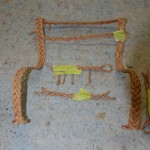
The reeds that make up the side panels of the arms and the back are inserted in holes around the perimeter of the seat frame. The broken reeds along with remaing paint filled these holes even following the stripping process. So, before any reweaving can start, all these holes must be drilled. We use a drill bit that is the same size as the original hole. Following the original angle, the holes are drilled. The result is an original hole that is clean, but not oversized.
The original seat was cane webbing in what is called a close weave pattern. Cane webbing is attached with a spline inserted, and glued, into a groove. You can see the spline where the cane webbing meets the wooden seat frame. The cane is pressed into the groove, followed by the spline. Now is the time to install this while the back and arms are not in the way of your hands. Children’s chairs are sometimes harder to work with than adult chairs due to the small size. Think of big hands in small spaces. Here you can see the rocker stripped with the holes drilled and the seat installed.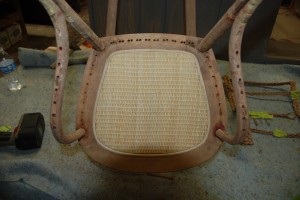
Next, the wooden back supports are wrapped using 6mm chair cane, and the arm panels are woven. Now it’s starting to take shape.
After the wicker braid is attached to the arms it provides the crest of the chair back. The back reeds are woven through the braid to secure the back and hide the ends. There was just enough left of the original back so we could duplicate the original design.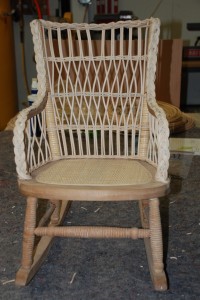
Many wicker pieces were originally finished with shellac. You can see what it might look like with a clear finish in the previous picture. Our client always remembered the rocker being red. After a coat of primer, and a little sanding, we finished the rocker with two coats of Benjamin Moore Million Dollar Red. Great color choice, as we knew this little rocker was going to look like a million bucks.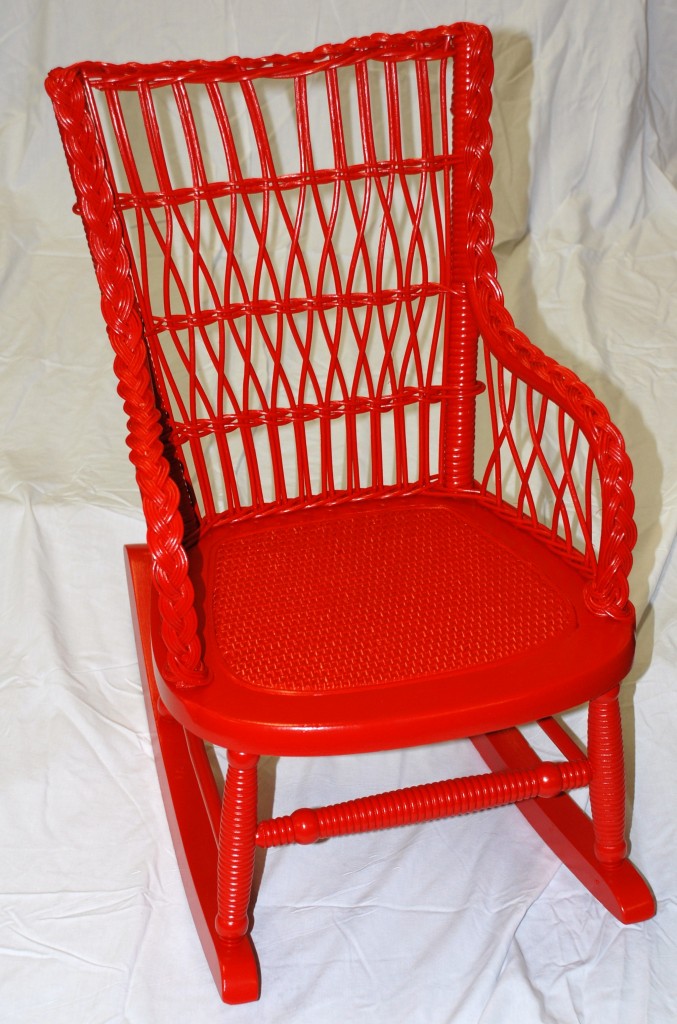
As the old timers retire, it is getting harder and harder to locate shops that have the expertise to restore wicker and cane furniture. It is a craft that demands patience, strength, and an artistic eye. While not the most profitable part of our business, I enjoy it and the results are often spectacular. We hope to continue offering cane and wicker restoration.
Soon, I’ll post about the embargo Indonesia has placed on the export of raw rattan (the material used for all wicker and cane furniture). This embargo is making it difficult and more expensive to obtain materials for restoration. If you have furniture that needs cane repair, you should consider having it restored sooner, rather than later.
We have several other cane and wicker projects to post about, so check back often. We would love to hear your comments about our work.

